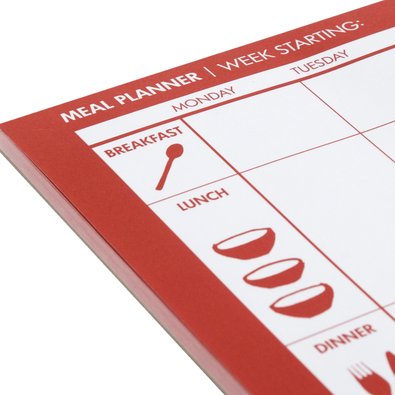- Home
- Blog
- Healthy Cooking
- 7 steps to kitchen organisation
7 steps to kitchen organisation
Written by Catherine Saxelby
on Tuesday, 09 November 2010.
Tagged: guides, healthy cooking, kitchen organisation, meal planning, sugar, tips
If you want to cook healthy meals, then the secret is to be organised. Here's how I manage to come up with healthy dinners most of the time. If you arrive home tired and hungry with nothing in the fridge or freezer, you are easy prey for take-aways and home-delivered fast food! Being organised also saves you time, money and stress. Follow my 7 steps to streamline your kitchen and make you more efficient.
1. Use a meal planner to plan dinners

Spend 15 minutes one night (Sunday is ideal) and jot down seven meals for the next seven nights (or just plan the working week). Find 7 recipes (or cook ones you know by heart) and check the fridge and cupboard to make sure you have the ingredients that you'll need.
- If you shop weekly, you'll need to plan and shop for 5 or 7 meals over the week.
- If you live near a supermarket or food market where you can shop daily, plan at least two dinners ahead.
Pin your meal planner to the refrigerator or a corkboard to let you and your family know what you'll be eating for the week. You can download my free planner or buy a Meal Planner Notepad from KikkiK:
| Monday | Spaghetti Bolognaise, salad |
| Tuesday | Tuna mornay |
| Wednesday | Steak, potato, green veg |
| Thursday | Chicken satays with peanut sauce, noodles, veg |
| Friday | Stir-fry of lamb with Asian veges, rice |
| Saturday | Dinner out |
| Sunday | Slow-cooked beef, mashed potato, green veg |
2. A well-stocked pantry
Keep these basics in the cupboard for quick meals:
- Pasta shells
- Brown rice
- Canned salmon or tuna
- Tomato pasta sauce or canned tomatoes
- Canned chick peas or kidney beans
- Variety of dried herbs and spice
- Oil
- Cous-cous
- Curry pastes/powder
Keep these ingredients in your freezer:
Frozen peas, pesto, spinach, berries, fish portions, burgers, fish fingers, calamari plus your own frozen soup, casseroles and Bolognaise sauce.
3. Clear out clutter
The kitchen is the centre of most homes and can be a clutter magnet where bills, school notes, old newspapers, homework and lunch boxes come to rest. It makes you more efficient to reduce the clutter or store it in boxes, folders or even in a 'clutter box'.
Ideally you want to create a clean, organized work space which encourages you to cook efficiently. Here's what I've found works:
- Make sure you can find cooking necessities easily to save time - the right (clean) utensils, chopping board, knives, cookware (wok, pans or frypan), pot holders, kitchen paper, towels, basic ingredients like oil, onions, garlic, flour, spices, stock or pasta sauce.
- Put ingredients and tools near where you will be using them between the stove and sink.
- Organise your pantry so food staples, such as stock, flour, canned beans and oils, are grouped together. Divide spices into groups eg savoury like basil, paprika or chilli and sweet like cinnamon, cloves and nutmeg.
- Keep tongs, spatulas, spoons and turners in a tool holder or large canister on the counter. Even better is a rack or magnetic tool bar attached to the wall to free up space.
- Unpack the dishwasher before you go to work so it's empty and ready for dirty items you use at night.
4. Jot down the shopping
I like to use a long thin spiral notepad that I can tear off each sheet after a shop. But a piece of paper or large Post-it note is fine to jot down when you run out of things. Whatever you use, a list saves time and stops you buying 'doubles' of things you already have or extras you don't need. Check what's in your refrigerator and freezer before you shop.
5. Use a board
Hang a small white board with a cork section in your kitchen. Use it for writing down what you are planning to cook for that night, pin a recipe you want to try out, and what leftovers are stored in the refrigerator or freezer. Handy for teenagers who want to heat up something quickly and can't 'find' anything in the fridge.
6. Write out your favourite recipes
Speaking to busy women, I've found that most have a repertoire of 8 or 10 favourite dinner meals that get rotated. For instance, I can cook from memory meatloaf, Italian meatballs, any sort of grill, beef stroganoff, tuna pasta bake, any pan-fried fish. But when I want to try a new recipe, I cut it out and throw it in a folder. The ones that I actually cook and like get put in a clear plastic sleeve in a ring-binder folder.
For inspiration, pick up recipe cards or tear out or photocopy your favourite recipes so you can flick through them.
7. Use the weekends to cook up
If you can, cook double quantities of recipes that freeze well or take a long time to prepare and cook. Then freeze into freezer containers in two- or four-portion packs for meals for another day. Suggestions for slow cooking recipes are here.
As long as you're at home during the day and can occasionally check, the weekend is the ideal time to do a slow-cooked casserole or curry or a big pot of soup.
Roast a chicken or a large piece of meat. They require little preparation or monitoring but a long cooking time. The leftovers can be used in all sorts of dishes including soups, casseroles, salads and sandwiches.
Foodwatch
The Good Stuff
The Boring Stuff
© 2025 Foodwatch Australia. All rights reserved
Website by Joomstore eCommerce





